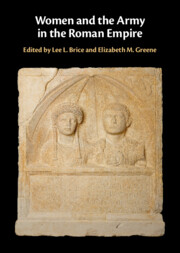Book contents
- Women and the Army in the Roman Empire
- Women and the Army in the Roman Empire
- Copyright page
- Dedication
- Contents
- Figures
- Maps
- Tables
- Contributors
- Acknowledgments
- Abbreviations
- Maps
- 1 Present but not Accounted For
- 2 Approaches to Women and the Roman Army
- 3 Agrippina and Company
- 4 Elite Marriage and Adultery in the Camp
- 5 Mother Courage and Her Children
- 6 Investigating Roles for Women inside Roman Military Bases through Artifact Distribution
- 7 (In)Visible Women and Children
- 8 Soldiers’ Wives en Route in Roman Egypt
- 9 The Role of Women in the Religious Activities of Roman Military Communities
- 10 Mater Castrorum
- 11 Women and the Military in the Age of Justinian
- Index
- References
2 - Approaches to Women and the Roman Army
The History of a Debate
Published online by Cambridge University Press: 24 October 2024
- Women and the Army in the Roman Empire
- Women and the Army in the Roman Empire
- Copyright page
- Dedication
- Contents
- Figures
- Maps
- Tables
- Contributors
- Acknowledgments
- Abbreviations
- Maps
- 1 Present but not Accounted For
- 2 Approaches to Women and the Roman Army
- 3 Agrippina and Company
- 4 Elite Marriage and Adultery in the Camp
- 5 Mother Courage and Her Children
- 6 Investigating Roles for Women inside Roman Military Bases through Artifact Distribution
- 7 (In)Visible Women and Children
- 8 Soldiers’ Wives en Route in Roman Egypt
- 9 The Role of Women in the Religious Activities of Roman Military Communities
- 10 Mater Castrorum
- 11 Women and the Military in the Age of Justinian
- Index
- References
Summary
The topic of women in Roman military communities (i.e., military women) did not suddenly appear in the late twentieth century. One could say its emergence is the result of the novel idea that women were present in most aspects of life in the ancient world. Women have been around the military much longer than the general or professional reader might realize. As a topic, military women have not generally been a group to which anyone paid sustained attention until the last decades of the twentieth century. The topic gained interest as social and cultural history became welcome components of historians’ toolboxes and as archaeological fieldwork has yielded new evidence and innovative methodologies have led to updated analyses of old artifacts. This chapter reviews the historiography of the debate over the long duration of Roman studies. In particular, the authors focus on how research into these military women and their families has slowly diversified and grown over the last three decades. The field is strong and growing to provide a more complete understanding of the Roman military.
- Type
- Chapter
- Information
- Women and the Army in the Roman Empire , pp. 21 - 53Publisher: Cambridge University PressPrint publication year: 2024

